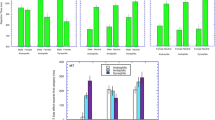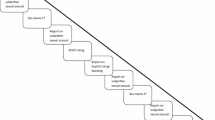Abstract
Patterns of genital arousal to sexual stimuli are somewhat different between men and women. Heterosexual males and homosexual males show clear category specific arousal that is consistent with their self-reported sexual preference. However, heterosexual women do not show this category specificity. In the present study, we attempted to measure a person’s automatic appraisals of stimuli with respect to the concept of sex via the use of implicit measures (the Implicit Association Test and the priming task). In three experiments, we showed that heterosexual females did not show a sex-related category specific response in favor of male versus female stimuli. However, this lack of specificity was not due to a lack of sex-related appraisals, but by equal appraisals of both male and female stimuli. On the other hand, heterosexual men, homosexual men, and homosexual women all showed automatic sex-related appraisals of stimuli that were category specific and in line with their self-reported sexual preference. The study shows difference in the pattern of sexual interest between genders at the earliest stages of the evaluation of a stimulus.




Similar content being viewed by others
Notes
It could be argued that sexual attraction is not on a bipolar scale as people can be attracted to both males and females. In places where we have used this composite analysis, we have also run analyses using the two concepts separately. The pattern of results reported was not substantially changed by this. Results are available from the corresponding author.
We also performed a supplementary analysis using only the trials where sex words were presented and then divided as to whether they were preceded by a male or female prime. The pattern of results reported here was the same for both methods.
A supplementary analysis using the D-scoring algorithm confirms the pattern of results reported here for the IAT task.
References
Abel, G. G., Huffman, J., Warberg, B., & Holland, C. L. (1998). Visual reaction time and plethysmography as measures of sexual interest in child molesters. Sexual Abuse: A Journal of Research and Treatment, 10, 81–95.
Baumeister, R. F. (2000). Gender differences in erotic plasticity: The female sex drive as socially flexible and responsive. Psychological Bulletin, 126, 347–374.
Bem, D. J. (1996). Exotic becomes erotic: A developmental theory of sexual orientation. Psychological Review, 103, 320–335.
Bem, D. J. (2000). Exotic becomes erotic: On the development of sexual attraction. Archives of Sexual Behavior, 29, 531–548.
Brown, A. S., Gray, N. S., & Snowden, R. J. (2009). Implicit measurement of sexual associations in child sex abusers: Role of victim type and denial. Sexual Abuse: A Journal of Research and Treatment, 21, 166–180.
Chivers, M. L. (2005). A brief review and discussion of sex differences in the specificity of sexual arousal. Sexual and Relationship Therapy, 20, 377–390.
Chivers, M. L., Rieger, G., Latty, E., & Bailey, J. M. (2004). A sex difference in the specificity of sexual arousal. Psychological Science, 15, 736–744.
Chivers, M. L., Seto, M. C., & Blanchard, R. (2007). Gender and sexual orientation differences in sexual response to sexual activities versus gender of actors in sexual films. Journal of Personality and Social Psychology, 93, 1108–1121.
Chivers, M. L., Seto, M. C., Lalumiere, M. L., Laan, E., & Grimbos, T. (2010). Agreement of self-reports and genital measures of sexual arousal in men and women: A meta-analysis. Archives of Sexual Behavior, 39, 5–56.
De Houwer, J. (2001). A structural and process analysis of the Implicit Association Test. Journal of Experimental Social Psychology, 37, 443–451.
Diamond, L. M. (2003). What does sexual orientation orient? A biobehavioral model distinguishing romantic love and sexual desire. Psychological Review, 110, 173–192.
Diamond, L. M. (2005). A new view of lesbian subtypes: Stable versus fluid identity trajectories over an 8-year period. Psychology of Women Quarterly, 29, 119–128.
Fazio, R. H., Jackson, J. R., Dunton, B. C., & Williams, C. J. (1995). Variability in automatic activation as an unobtrusive measure of racial attitudes: A bona fide pipeline? Journal of Personality and Social Psychology, 69, 1013–1027.
Gray, N. S., & Snowden, R. J. (2009). The Implicit Association Test as a measure of sexual interest. In D. Thornton & D. R. Laws (Eds.), Cognitive approaches to the assessment of sexual interest in sexual offenders (pp. 101–123). New York: Wiley.
Greenwald, A. G., McGhee, J. L., & Schwartz, J. L. (1998). Measuring individual differences in implicit cognition: The Implicit Association Test. Journal of Personality and Social Psychology, 74, 1464–1480.
Greenwald, A. G., Nosek, B. A., & Banaji, M. R. (2003). Understanding and using the Implicit Association Test: I. An improved scoring algorithm. Journal of Personality and Social Psychology, 85, 197–216.
Janssen, E., Everaerd, W., Spiering, M., & Janssen, J. (2000). Automatic processes and the appraisal of sexual stimuli: Toward an information processing model of sexual arousal. Journal of Sex Research, 37, 8–23.
Karpinski, A., & Steinman, R. B. (2006). The Single Category Implicit Association Test as a measure of implicit social cognition. Journal of Personality and Social Psychology, 91, 16–32.
Lang, P. J., Bradley, M. M., & Cuthbert, B. N. (1997). International Affective Picture System (IAPS): Technical manual and affective ratings. National Institute for Mental Health Center for the Study of Emotion and Attention.
Laumann, E. O., Gagnon, J. H., Michael, R. T., & Michaels, S. (1994). The social organization of sexuality: Sexual practices in the United States. Chicago: University of Chicago Press.
Lippa, R. A. (2006). Is high sex drive associated with increased sexual attraction to both sexes? Psychological Science, 17, 46–52.
Lippa, R. A., & Arad, S. (1997). The structure of sexual orientation and its relation to masculinity, femininity, and gender diagnosticity: Different for men and women. Sex Roles, 37, 187–208.
Nosek, B. A., & Banaji, M. R. (2001). The Go/No-Go association task. Social Cognition, 19, 625–664.
Pattatucci, A. M. L., & Hamer, D. H. (1995). Development and familiality of sexual orientation in females. Behavior Genetics, 25, 407–420.
Petersen, J. L., & Hyde, J. S. (2011). Gender differences in sexual attitudes and behaviors: A review of meta-analytic results and large datasets. Journal of Sex Research, 48, 149–165.
Ponseti, J., & Bosinski, H. A. G. (2010). Subliminal sexual stimuli facilitate genital response in women. Archives of Sexual Behavior, 39, 1073–1079.
Rullo, J. E., Strassberg, D. S., & Israel, E. (2010). Category-specificity in sexual interest in gay men and lesbians. Archives of Sexual Behavior, 39, 874–879.
Savin-Williams, R. C. (2006). Who’s gay? Does it matter? Current Directions in Psychological Science, 15, 40–44.
Singer, B. (1984). Conceptualizing sexual arousal and attraction. Journal of Sex Research, 20, 230–240.
Snowden, R. J., Craig, R. L., & Gray, N. S. (2011). Indirect behavioral measures of cognition among sexual offenders. Journal of Sex Research, 48, 192–217.
Snowden, R. J., Wichter, J., & Gray, N. S. (2008). Implicit and explicit measurements of sexual preference in gay and heterosexual men: A comparison of priming techniques. Archives of Sexual Behavior, 37, 558–567.
Symons, D. (1979). The evolution of human sexuality. New York: Oxford Press.
Udry, J. R., & Chantala, K. (2006). Masculinity-femininity predicts sexual orientation in men but not in women. Journal of Biosocial Science, 38, 797–809.
Wolchik, S. A., Spencer, S. L., & Lisi, I. S. (1983). Volunteer bias in research employing vaginal measures of sexual arousal. Archives of Sexual Behavior, 12, 399–408.
Acknowledgment
Thanks to Helen Maris, Kate Epsom, Zoe Maudsley, Frances Jarrett, Anthony Brown, and Helen Weir for help with data collection.
Author information
Authors and Affiliations
Corresponding author
Appendix 1
Appendix 1
Words and pictures used in the experiments. In the experiments, these pictures appeared in color.
Sexually attractive | Sexually unattractive |
|---|---|
Arousing | Forbidding |
Erotic | Repulsive |
Attractive | Disgusting |
Stimulating | Repugnant |
Sensual | Repellent |
Exciting | Ugly |
Appealing | Revolting |
Sexy | Repelling |

Rights and permissions
About this article
Cite this article
Snowden, R.J., Gray, N.S. Implicit Sexual Associations in Heterosexual and Homosexual Women and Men. Arch Sex Behav 42, 475–485 (2013). https://doi.org/10.1007/s10508-012-9920-z
Received:
Revised:
Accepted:
Published:
Issue Date:
DOI: https://doi.org/10.1007/s10508-012-9920-z




